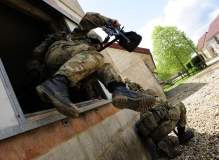

When the residents of Imber, a sleepy village in Wiltshire were called into a town meeting on 1 November 1943, they couldn’t possibly have guessed what was coming. They were given just 47 days to evacuate so American troops could practice urban manoeuvres as part of preparations for landing in Europe.
While Imber had been a settlement since Saxon times, it could hardly have been described as peaceful. Much of the surrounding fields and farmland on Salisbury Plain had already been sold to the War Office, and one can image they were regularly awoken by shellfire more often than a farmyard cockerel’s crow.
It seems Imberites were agreeable to playing their part in the war effort – they even left tinned food for troops when they departed – but had they known they’d never return and their village would be retained for military use to this day, pockmarked with missile damage, they might not have been so willing.
The story of Imber is an exemplar for a series of villages either purpose-built by, or annexed by, the British Ministry of Defence (MOD) for live-fire training. Its modern descendants have been lovingly crafted as accurate facsimiles of theatres thousands of miles away, and even populated with actors inseparable from locals, with accurate sounds and smells. But even Imber had historic forebears.
The fake trenches of World War I
Military personnel and equipment helped turn the tide for people left homeless and stranded after the unrelenting winter storms that hit the U.
When a Hampshire councillor studied 1950s aerial photographs of the MOD’s Browndown site in looking for signs of Second World War pillboxes and an airfield, he stumbled across something quiote unexpected; a grid system of zig-zag lines like the crenulations of a castle.
Over an area half a kilometre on each side, Roy Harper had stumbled upon the site where the MOD had prepared troops for their first taste of trench warfare. So secret was the site that no military records of its use can be found, but archaeologists and historians speculate that the thousands of soldiers who left for and returned from the war via Gosport learned not only how to conduct trench warfare but how to build the most secure trenches. For example, the foremost trenches were built jagged so any enemy soldier entering could not get a line of fire, but communication trenches were wider for speedy access.
Now, military and civilian volunteers are helping record the site for posterity as part of the Home Front Legacy campaign.
Cold War curiosities
Far from easing after the two World Wars, tensions barely lifted before segueing into the threat from the East during the decades of the Cold War, and the wary British military began preparing to roll tanks back across Germany to engage the Soviet Union if needed.
Imber has an unusual neighbour on Salisbury Plain, but with a distinctly more continental ambience. Copehill Down is a training facility designed to look like a Bavarian village, providing an urban backdrop for exercises the MOD dubs FIBUA (Fighting In Built Up Areas).
Despite the Germanic feel, British humour sits at its heart – the phony church at its centre is named St Jude’s, after the patron saint of lost causes.
As the Cold War drew to a close, Copehill Down was also used to prepare troops for conflict in the Balkans and Northern Ireland, and then after the Warsaw Pact was signed, a shanty town of narrow streets was added to prepare troops for Iraq and Afghanistan.
Further afield, as remote in miles as it is in environment from Salisbury Plain, the British Army Training Unit Suffield (BATUS) in Alberta, Canada, was originally founded for British chemical weapons testing. During the ’70s and ’80s, its large expanse of prairie known as the Suffield Block began being used for Cold War live firing exercises.
The main exercise season at BATUS still takes place from May to October, while during the inhospitable winters it is given over to Arctic warfare training involving tanks, armoured vehicles and helicopters.
The Middle East in middle England
“Hyper-realistic” training takes military learning out of the classroom and on to the battlefield using actors, Hollywood-style explosions and combat wound effects.
The conflicts in Iraq and Afghanistan brought about a need for a new type of immersive training environment to prepare troops for unfamiliar asymmetric urban warfare. Stanford Training Area, or STANTA, a site near Thetford in Norwich, started life in 1942 as a ‘Nazi village’ used in preparation for the D-Day landings, but in 2009 evolved into an Afghan village replicated with unprecedented accuracy.
Not content with duplicating the cramped and bustling streets, houses, markets and mosques troops might encounter, an extra dimension of realism was added with actors, including amputees, playing Afghan soldiers and civilians speaking Pashto. Museum technicians were even brought in to install a system to pump out authentic smells, like meat in the marketplace and sewers festering in the heat.
It is also a designated live-firing area, and in September 2013 it was used to carry out the first live firing of the Boeing AH-64 Apache attack helicopter’s 30mm cannon, and to prepare its air and ground crew for Helmland.
So what will future urban training areas look like? The makeup of the next potential theatres of operation is a question currently vexing the Ministry of Defence in all areas of procurement. While vehicles, aircraft and vessels can incorporate a degree of flexibility, the environments towards which they are targeted could vary wildly.
The next villages to spring up on Salisbury Plain could bring a whole new part of the world to the heartland of England.
Follow Berenice Baker on Google+


.gif)

